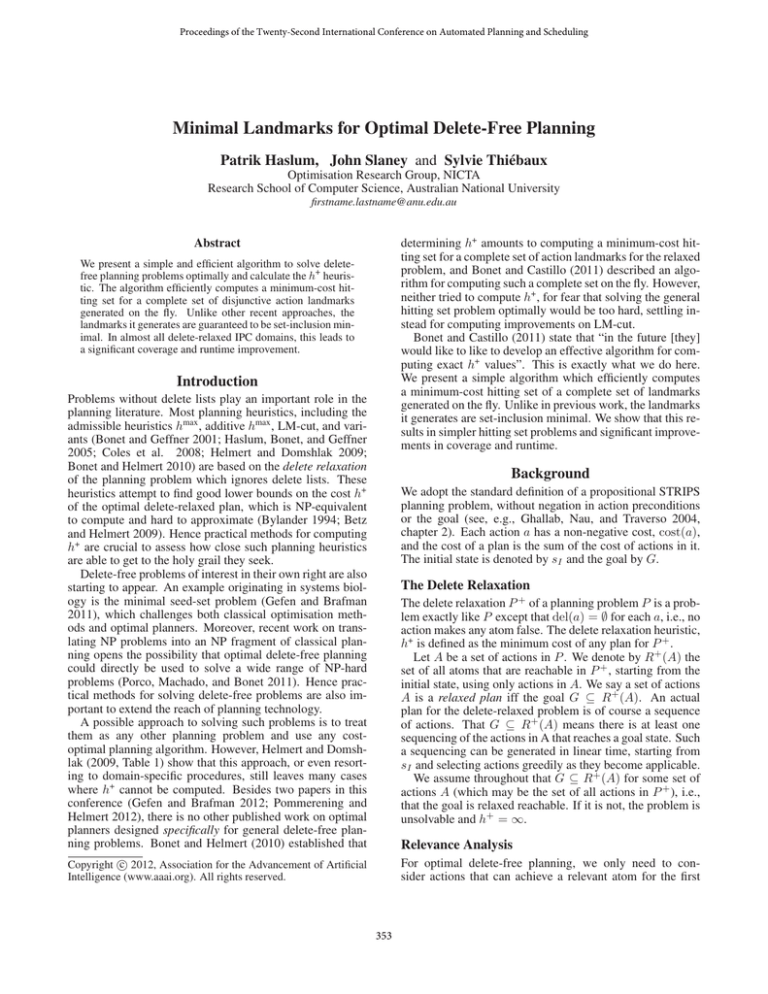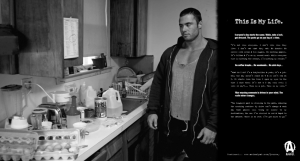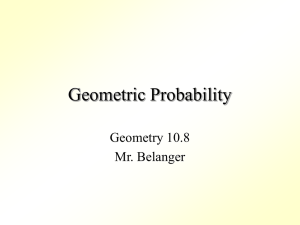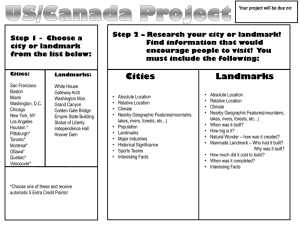
Proceedings of the Twenty-Second International Conference on Automated Planning and Scheduling
Minimal Landmarks for Optimal Delete-Free Planning
Patrik Haslum, John Slaney and Sylvie Thiébaux
Optimisation Research Group, NICTA
Research School of Computer Science, Australian National University
firstname.lastname@anu.edu.au
determining h+ amounts to computing a minimum-cost hitting set for a complete set of action landmarks for the relaxed
problem, and Bonet and Castillo (2011) described an algorithm for computing such a complete set on the fly. However,
neither tried to compute h+ , for fear that solving the general
hitting set problem optimally would be too hard, settling instead for computing improvements on LM-cut.
Bonet and Castillo (2011) state that “in the future [they]
would like to like to develop an effective algorithm for computing exact h+ values”. This is exactly what we do here.
We present a simple algorithm which efficiently computes
a minimum-cost hitting set of a complete set of landmarks
generated on the fly. Unlike in previous work, the landmarks
it generates are set-inclusion minimal. We show that this results in simpler hitting set problems and significant improvements in coverage and runtime.
Abstract
We present a simple and efficient algorithm to solve deletefree planning problems optimally and calculate the h+ heuristic. The algorithm efficiently computes a minimum-cost hitting set for a complete set of disjunctive action landmarks
generated on the fly. Unlike other recent approaches, the
landmarks it generates are guaranteed to be set-inclusion minimal. In almost all delete-relaxed IPC domains, this leads to
a significant coverage and runtime improvement.
Introduction
Problems without delete lists play an important role in the
planning literature. Most planning heuristics, including the
admissible heuristics hmax , additive hmax , LM-cut, and variants (Bonet and Geffner 2001; Haslum, Bonet, and Geffner
2005; Coles et al. 2008; Helmert and Domshlak 2009;
Bonet and Helmert 2010) are based on the delete relaxation
of the planning problem which ignores delete lists. These
heuristics attempt to find good lower bounds on the cost h+
of the optimal delete-relaxed plan, which is NP-equivalent
to compute and hard to approximate (Bylander 1994; Betz
and Helmert 2009). Hence practical methods for computing
h+ are crucial to assess how close such planning heuristics
are able to get to the holy grail they seek.
Delete-free problems of interest in their own right are also
starting to appear. An example originating in systems biology is the minimal seed-set problem (Gefen and Brafman
2011), which challenges both classical optimisation methods and optimal planners. Moreover, recent work on translating NP problems into an NP fragment of classical planning opens the possibility that optimal delete-free planning
could directly be used to solve a wide range of NP-hard
problems (Porco, Machado, and Bonet 2011). Hence practical methods for solving delete-free problems are also important to extend the reach of planning technology.
A possible approach to solving such problems is to treat
them as any other planning problem and use any costoptimal planning algorithm. However, Helmert and Domshlak (2009, Table 1) show that this approach, or even resorting to domain-specific procedures, still leaves many cases
where h+ cannot be computed. Besides two papers in this
conference (Gefen and Brafman 2012; Pommerening and
Helmert 2012), there is no other published work on optimal
planners designed specifically for general delete-free planning problems. Bonet and Helmert (2010) established that
Background
We adopt the standard definition of a propositional STRIPS
planning problem, without negation in action preconditions
or the goal (see, e.g., Ghallab, Nau, and Traverso 2004,
chapter 2). Each action a has a non-negative cost, cost(a),
and the cost of a plan is the sum of the cost of actions in it.
The initial state is denoted by sI and the goal by G.
The Delete Relaxation
The delete relaxation P + of a planning problem P is a problem exactly like P except that del(a) = ∅ for each a, i.e., no
action makes any atom false. The delete relaxation heuristic,
h+ is defined as the minimum cost of any plan for P + .
Let A be a set of actions in P . We denote by R+ (A) the
set of all atoms that are reachable in P + , starting from the
initial state, using only actions in A. We say a set of actions
A is a relaxed plan iff the goal G ⊆ R+ (A). An actual
plan for the delete-relaxed problem is of course a sequence
of actions. That G ⊆ R+ (A) means there is at least one
sequencing of the actions in A that reaches a goal state. Such
a sequencing can be generated in linear time, starting from
sI and selecting actions greedily as they become applicable.
We assume throughout that G ⊆ R+ (A) for some set of
actions A (which may be the set of all actions in P + ), i.e.,
that the goal is relaxed reachable. If it is not, the problem is
unsolvable and h+ = ∞.
Relevance Analysis
For optimal delete-free planning, we only need to consider actions that can achieve a relevant atom for the first
c 2012, Association for the Advancement of Artificial
Copyright Intelligence (www.aaai.org). All rights reserved.
353
1:
2:
3:
4:
5:
6:
time. This enables more aggressive, yet still optimalitypreserving, pruning of irrelevant actions. The standard relevance analysis method in planning is to backchain from the
goal: goal atoms are relevant, an action that achieves a relevant atom is relevant, and atoms in the precondition of a relevant action are relevant. We strengthen this analysis in the
delete-free case, by considering as relevant only actions that
are possible first achievers of a relevant atom. Action a is a
possible first achiever of atom p if p ∈ add(a) and a is applicable in a state that is relaxed reachable with only actions
that do not add p, i.e., if pre(a) ⊆ R+ ({a | p 6∈ add(a)}).
L=∅
A=∅
while G 6⊆ R+ (A) do
L = L ∪ N EW L ANDMARK(A)
A = M IN C OST H ITTING S ET(L)
return A
Figure 1: Basic Iterative Landmark Algorithm
1:
2:
3:
4:
5:
6:
7:
8:
9:
10:
11:
Iterative Minimal Landmark Generation
A disjunctive action landmark (landmark, for short) of a
problem P is a set of actions such that at least one action
in the set must be included in any valid plan for P . Hence,
for any collection of landmarks L for P , the set of actions
in any valid plan for P is a hitting set for L, i.e., contains an
action from each set in L.
For any set of actions A such that G 6⊆ R+ (A), the complement A of A (w.r.t. the whole set of actions) is a disjunctive action landmark for P + . If A is an inclusion-maximal
such “relaxed non-plan”, A is an inclusion-minimal landmark, since if some proper subset of A were also a landmark, A would not be maximal. This leads to the following
algorithm for computing h+ :
Initialise the landmark collection L to ∅. Repeatedly (1)
find a minimum-cost hitting set A for L; (2) test if G ⊆
R+ (A); and if not, (3) extend A, by adding actions, to
a maximal set A0 such that G 6⊆ R+ (A0 ), and add the
complement of A0 to the landmark collection.
The algorithm terminates when the hitting set A contains
enough actions to reach the goal and is thus a relaxed plan.
There is no lower-cost relaxed plan, because any plan for
P + must contain an action from every landmark in L, and
A is a minimum-cost hitting set. Finally, the algorithm eventually terminates, because every iteration adds a new landmark, which cannot already be in L as it is not hit by A, and
there is only a finite set of minimal landmarks for P + .
The algorithm is given in Figure 1. Details about the
procedures N EW L ANDMARK (which implements step (3)
above) and M IN C OST H ITTING S ET are given below in the
sections on ‘Testing Relaxed Reachability’ and ‘Finding a
Minimum-Cost Hitting Set’ respectively.
L=∅
S
while G 6⊆ R+ ( l∈L l) do
S
L = L ∪ N EW L ANDMARK( l∈L l)
A = M IN C OST H ITTING S ET(L)
while G 6⊆ R+ (A) do
L = L ∪ N EW L ANDMARK(A)
H = A PX H ITTING S ET(L)
if G ⊆ R+ (A ∪ H) then A = H
else A = A ∪ H.
if G ⊆ R+ (A) then A = M IN C OST H ITTING S ET(L)
return A
Figure 2: Iterative Landmark Algorithm with improvements
a relaxed plan, it is the solution; if not then the algorithm
continues. One candidate for H is the hitting set from the
previous iteration extended with the cheapest action in the
new (unhit) landmark. Another is the set found by the standard greedy algorithm using the weighted degree heuristic
(Chvatal 1979), which greedily adds actions in increasing
order of the ratio of their cost to the number of landmarks
they hit. We take whichever of these two has lower cost.
Second, we collect the union of recently found hitting
sets, and first try using this in place of only the last hitting
set. If this larger set is also not a relaxed plan, it is used
as the starting point to generate a new landmark. If it is a
relaxed plan, earlier hitting sets are forgotten and the collection reset to the last hitting set only. The effect of using a
larger relaxed non-plan is similar to that of “saturation” used
by Bonet & Castillo (2011): it makes new landmarks have
less in common with those already in L, thus creating easier
hitting set problems and faster convergence to the optimal
h+ value. Taking this idea a step further, as long as the set
of all actions appearing in current landmarks is not a relaxed
plan, we can use that to generate the next landmark, which
will be disjoint from all previous ones. We do this (lines 2
and 3 of Figure 2) to seed L and A before the main loop.
Two steps in this algorithm are frequently repeated, and
therefore important to do efficiently: the first is testing if
the goal is relaxed reachable with a given set of actions, and
the second is finding a hitting set with minimum cost. Their
implementations are detailed in the following sections.
Improvements to the Algorithm
In fact, any set of actions that hits every landmark in L but
is not a relaxed plan can be used as the starting point to generate a new landmark, not in L. This observation is the basis
for two improvements to the algorithm: First, it is not necessary to find an optimal hitting set in every iteration. Only
when the hitting set A is a relaxed plan do we need to verify that its cost is minimal. Thus, we use a fast approximate
algorithm to generate hitting sets H, updating A as we go
(lines 8–9 of Figure 2: see also next paragraph below), until
one that reaches the relaxed goal is found. Only then do we
apply the optimal branch-and-bound algorithm, detailed below, using the cost of the non-optimal A as an initial upper
bound. After this, A is a cost-minimal hitting set. If it is also
Testing Relaxed Reachability
R+ (A), the set of atoms that are relaxed reachable with actions A, can be computed in linear time by a variant of Dijkstra’s algorithm: Keep track of the number of unreached
preconditions of each action, and keep a queue of newly
reached atoms, initialised with atoms true in sI . Dequeue
one atom at a time until the queue is empty; when dequeueing an atom, decrement the precondition counter for the actions that have this atom as a precondition, and if the counter
354
Caching Because the branch-and-bound algorithm is invoked recursively on subsets of L, it may prove increased
lower bounds on the cost of hitting these subsets. Improved
bounds are cached, and used in place of the lower bound
calculation whenever a subset is encountered again. This
is implemented by a transposition table, taking the “state”
cached as the subset of landmarks that remain to be hit. In
the course of computing h+ , we will be solving a series of
hitting set problems, over a strictly increasing collection of
landmarks: ∅, {l1 }, {l1 , l2 }, etc. Cached lower bounds may
be used not only if a subset of L is encountered again within
the same search, but also if it is encountered while solving a
subsequent hitting set problem.
reaches zero, mark atoms added by the action as reached and
place any previously unmarked ones on the queue.1
When generating a new landmark, we perform a series
of reachability computations, with mostly increasing sets of
actions, i.e. H, H ∪ {a1 }, H ∪ {a1 , a2 }, etc. Therefore,
each reachability test can be done incrementally. Suppose
we have computed R+ (A), by the algorithm above, and
now wish to compute R+ (A ∪ {a}). If pre(a) 6⊆ R+ (A),
R+ (A∪{a}) equals R+ (A), and the only thing that must be
done is to initialise a’s counter of unreached preconditions.
If not, mark and enqueue any previously unreached atoms in
add(a), and resume the main loop until the queue is again
empty. If the goal becomes reachable, we must remove the
last added action (a) from the set, and thus must restore the
earlier state of reachability. This is done by saving the state
of R+ (A) (including precondition counters) before computing R+ (A ∪ {a}), and copying it back if needed.
Decomposition Suppose the collection of landmarks can
be partitioned into subsets L1 , . . . Lk , such that no two landmarks in different partitions have any action in common.
Then, an optimal hitting set for the entire collection can be
constructed by finding, independently, an optimal hitting set
for each partition and taking their union. It is rarely the case
that the entire landmark collection can be partitioned in this
way, but as we select actions to include and remove landmarks that have already been hit, the set that remains becomes sparser. Thus, opportunities for decomposition can
arise during the search. We found that most of the time
when a split occurs, all partitions but one consist of only one
or two landmarks. These tiny subproblems are solved optimally by simple special-purpose routines, and their optimal
cost used to update the bounds on remaining subproblems.
Finding a Minimum-Cost Hitting Set
Finding a minimum-cost hitting set over the set of landmarks
L is an NP-hard problem. We solve it using a recursive
branch-and-bound algorithm, with some improvements.
When finding a hitting set for {l1 , . . . , lm }, we already have an optimal hitting set for {l1 , . . . , lm−1 }.
H ? ({l1 , . . . , lm−1 }) is clearly a lower bound on
H ? ({l1 , . . . , lm }), and an initial upper bound can be
found by taking H ? ({l1 , . . . , lm−1 }) + mina∈lm cost(a).
These bounds are often very tight, which limits the amount
of search. E.g. if lm contains any zero-cost action, the
initial upper bound is the lower bound, and is thus optimal.
Given a set L = {l1 , . . . , lm } of landmarks to hit, we pick
a landmark li ∈ L; the minimum cost of a hitting set for L is
H ? (L) = mina∈li H ? (L − {l | a ∈ l}) + cost(a). In our implementation, we pick the landmark whose cheapest action
has the highest cost, using landmark size to break ties (preferring smaller). We branch on which action in li to include
in the hitting set, cheapest action first. Next, we describe the
lower bounds, and three improvements to the basic branchand-bound scheme, that we use.
Dominance Eliminating dominated elements is a standard
technique to speed up hitting set algorithms (e.g. Beasley
1987). Let L(a) be the subset of landmarks in the current
collection that include action a. If, for actions a and a0 ,
L(a0 ) ⊆ L(a) and cost(a) ≤ cost(a0 ), we say that a dominates a0 . Dominated actions are not considered for inclusion
in the hitting set, since the dominating action hits at least the
same sets, and adds no more to the cost. If two actions hit
the same landmarks and have the same cost, both dominate
each other, but obviously only one can be excluded.
Dominance is determined by the current landmark collection, so it must be updated when a new landmark is added.
However, we do not update dominance as landmarks are removed during search.3
Lower Bounds We use the maximum of two lower bounds
on H ? (L). The first is obtained by selecting a subset L0 ⊂ L
s.t. l ∩l0 = ∅ for any l, l0 ∈ L0 , i.e., a set of pair-wise disjoint
landmarks,
and summing the costs of their cheapest actions,
P
i.e., l∈L0 mina∈l cost(a). Finding the set L0 that yields
the maximum lower bound amounts to solving a weighted
independent set problem, but there are reasonably good and
fast approximation algorithms (e.g. Halldórsson 2000). The
second bound is simply the continuous relaxation of the integer programming formulation of the hitting set problem:
X
X
min
cost(a)xa s.t.
xa ≥ 1 ∀l ∈ L, xa ∈ {0, 1}∀a
a
Results and Conclusions
We compare our method of computing landmarks with that
presented by Bonet & Castillo (2011), when each is used by
our Iterative Landmark Algorithm to generate cost-optimal
relaxed plans. Bonet & Castillo propose a method based on
finding cuts in a graph, similar to how the LM-Cut heuristic
is computed. This is not guaranteed to find minimal landmarks, but involves essentially only one relaxed reachability
a∈l
Relaxing the integrality constraint results in an LP, which we
solve using standard techniques (simplex).2
a local improvement loop on the dual of the above LP. We found
that although the bound it gives is often close to the optimal solution to the LP, solving the LP to optimality still pays off.
3
We also do not remove landmarks which become subsumed
as actions are removed on backtracking. Iterating these inferences
to a fixpoint yields a powerful propagator (De Kleer 2011), whose
implementation we leave as future work.
1
This is essentially the same algorithm as the implementation of
relaxed plan graph construction described by Hoffmann & Nebel
(2001, Section 4.3). Liu, Koenig & Furcy (2002) also discuss a
similar algorithm, referring to it as “Generalised Dijkstra”.
2
Fisher & Kedia (1990) describe a lower bound which is
weaker, but cheaper to compute, using a greedy approximation and
355
Domain
computation, whereas our method may use up to O(|A|) of
them. In our experiments, all aspects of the implementation
apart from landmark generation are identical.
We compare them across problem sets from IPC 1998–
2011, counting the number of problems solved within a 30
minute CPU time limit. The IPC 2000 Blocksworld and Logistics problem sets include the larger instances intended for
planners with hand-coded control knowledge. For IPC 2008
& 2011 domains, we use the problem sets from the sequential satisficing track.
Table 1 summarises the results: for each domain, it shows
the total number of problems (col 1), the number solved by
each method (col 2), average number of landmarks generated (over all problems, col 3), average time in seconds (over
problems solved by both, col 4) – see Figure 3 (left) for runtimes on individual problems – and average width (cf. below) of hitting set problems (over planning problems solved
by both, col 5). As a point of reference, we include the number of problems for which Helmert and Domshlak (2009)
report they could compute h+ , using domain-specific procedures or heuristic search with existing admissible heuristics.
Clearly, investing more time into computing minimal
landmarks pays off. Our method solves a large superset of
the problems solved by Bonet & Castillo’s method, and is
often significantly faster. There are two main reasons for
this: first, our method usually requires fewer landmarks to
be generated before a relaxed plan is found; second, and
more significant, using minimal landmarks leads to simpler
hitting set problems. The optimal hitting set solver needs to
be invoked on far fewer problems (a quarter, on average),
and as shown in Figure 3 (right), those are solved with fewer
node expansions (less than a third, on average). The worst
case complexity of the hitting set problem is bounded by
the width of the set collection (Bonet and Helmert 2010).
We also found a strong correlation between width and the
practical problem difficulty (70% of problems with abovemedian width also have an above-median number of node
expansions, and vice versa), though there is no simple quantitative relationship. Minimal landmarks yield problems of
lower width, and since the optimal hitting set computation
dominates runtime in most cases, this leads to a significant
speedup. Of course, this comes at a cost: our method spends
an average of 31.1% of its time generating landmarks, compared to only 3.3% using Bonet & Castillo’s method. In the
Schedule domain, all hitting set problems encountered are
very easy (accounting for less than 15 seconds in total on
the hardest instance), so the difference in runtime is dominated by the overhead for generating minimal landmarks.
Our algorithm solves as many or more problems than
heuristic search or domain-specific methods in nearly all domains. Notable exceptions are Satellite (for which the results reported by Helmert and Domshlak were obtained by
a domain-specific method) and TPP. Using this larger data
set, we can estimate the average error of the LM-Cut heuristic, relative to h+ , on initial states to 3.5% over unit-cost
problems and 15.3% over non-unit cost domains. Helmert
and Domshlak estimate the average relative error to be only
2.5%, but note that “It is likely that in cases where we cannot
determine h+ , the heuristic errors are larger [...]”, a hypothesis that we can now confirm.
#
Airport
50
Blocksworld 3-ops (small) 35
Blocksworld 3-ops (large)
66
Blocksworld 4-ops (small) 35
Blocksworld 4-ops (large)
66
Depots
22
Driverlog
20
Freecell
60
Gripper
20
Logistics’00 (small)
27
Logistics’00 (large)
52
Logistics’98
35
Miconic
150
MPrime
35
Mystery
28
Pathways
30
Pipesworld NoTankage
50
Pipesworld Tankage
50
PSR (small)
50
Rovers’06
40
Satellite’04
36
Schedule
500
Storage
30
TPP
30
Trucks (ADL)
30
ZenoTravel
20
Cybersec
30
Elevators
30
Openstacks (ADL)
30
ParcPrinter
30
PegSol
30
Scanalyzer
30
Sokoban
30
Transport
30
Woodworking
30
Barman
20
FloorTile
20
NoMystery
20
Visitall
20
# solved
ML BC HD
50 50 37
35 35
53 18
35 35 35
66 66
18 12 10
13
8 14
17
0
6
20 20 20
27 27 26
23 10
15
6 10
150 99 150
28 17 24
25 19 18
28
8
5
20
9 18
15
6 11
50 50 50
18 19 14
8
5
9
500 500
23 20
15 15 18
30 30 10
13 10 13
30 27
27 11
30 30
30 30
30 30
15
4
30 30
6
6
19
9
18
5
12
9
5
4
2
0
avg. #lms
ML
BC
246 247
36
56
305 595
17
17
66
66
164 412
170 556
275 531
47
47
46
53
331 485
373 710
57 704
79 546
68 441
196 315
243 997
219 756
3
3
365 581
261 573
101
92
115 214
255 654
45
77
135 334
138 298
437 737
124 162
79 100
40
61
118 446
59 147
522 911
113 302
264 1372
248 559
324 175
1624 1636
avg. time (s)
ML
BC
21.91 14.90
0.19
6.24
102.33 193.67
0.01
0.01
0.57
0.54
0.33
9.00
0.15 63.35
0.01
0.06
1.23
0.02
0.08
0.84
0.46
0.06
0.25
0.07
0.05
26.31
0.18
30.91
1.21
5.50
0.38
0.91
21.16
21.43
1.31
0.20
0.05
0.03
0.20
0.45
0.18
7.46
10.08
1.58
0.01
0.21
158.45
0.09
160.66
93.69
45.72
207.04
7.94
19.30
0.05
88.35
3.72
8.25
41.71
28.91
3.01
91.81
157.68
176.87
7.87
0.36
0.16
240.48
7.58
1.83
26.02
147.71
248.97
13.40
avg. width
ML BC
18
20
6
25
18 118
1
1
1
1
23
92
29
93
1
9
60
5
11
17
17
18
29
19
1
54
26
7
25
32
7
29
57
180
1
9
24
8
21
43
12
133
104
44
1
13
141
22
250
167
120
86
120
121
1
101
80
9
64
98
40
70
122
412
79
13
39
158
78
85
50
480
220
165
1e 03
1e 01
1e+01
Minimal Landmark Generation
6
4
2
0
−2
+
++
log10(HS time with BC / HS time with ML)
1e+01
+ +
+
+
+
+
+
+
+
+
+
+
+
+
−4
1e+03
+
+
+ +
+ ++ + +++
+
+
+ ++ +
+
+
+
++ +
+
+ + +
+++ ++
++ +
+
+
+
+++ + + +
+ ++
++
+
+ +
++
++
++
+
++
+ ++
+ +
+ +
+ ++ +
+
+
+
+
+
+
+
+
++ + +
+++ +++ + ++ ++ +++++
+ +
+
+ ++
+++
++ ++
++ ++ +
++
++++
+++
+
+
+
+
+
+
+
+
+
+
+
+
+
+ + + + +
+ ++ +++
++++
+ +++
++++
+
+ +++ + +++ + + +++++++++
++
+
+++ + + +++
++
+ +
+
+ + +
++
++++ +++
+
+++
++
++++ + +++++ + + +
++++++
+ ++ +
+++
+++
++ +
++++
++++ +
++ + +
+ +++++ ++
+ + +
++++
++
+ + + ++
++
+ ++++
++++
++ + ++ ++++
+ ++++ +
+
+
+
+
+
+
++
+
+
+
+
+
+++++++
++
+
++++ ++
+ +++
+ + + ++
+ ++
++
++++++++++
++++
++
++
+
+ +++
+ ++++ ++
+++
+++++
++ + +
+++++++++++
++++
+ +++ +++ +
++++ ++++++
+++
++ ++ ++ +++++++++++ +++
+
+
++ +++++ ++
+ + ++++ +
++ +
++ ++ + ++++++++++++ +
+ + + ++++++
++++++ +++
++++
+ ++
+ +++
+++++ +
++
+ +++
+++
+ ++
++++
++
++
++
+
++ ++ +
+
+
+
+
+ ++ +
+ ++++ +
+ +++ +
+ +
+
+
1e−01
1e−03
Bonet−Castillo Landmark Generation
Table 1: Comparison between our Minimal Landmark (ML)
generation method, Bonet & Castillo’s method, and results
reported by Helmert and Domshlak (HD). Domains with
non-unit action costs are grouped below the line.
1e+03
0
20
40
60
80
100
Frequency
Figure 3: Left: Time to compute h+ using Minimal Landmark Generation and Bonet-Castillo methods, on problems
solved by both. The schedule domain (500 instances) is in
gray. Right: Distribution of the relative time spent on hitting
set computation with the two methods.
We also tried the algorithm on the minimal seed-set problem. It solves all instances, in marginally less time (2/3 on
average) than that reported by Gefen and Brafman (2011)
for their domain-specific algorithm.
Acknowledgements P. Haslum and S. Thiébaux are supported by ARC Discovery Project DP0985532 “Exploiting
Structure in AI Planning”. The authors would also like to
acknowledge the support of NICTA which is funded by the
Australian Government as represented by DBCDE and ARC
through the ICT Centre of Excellence program.
356
References
In Proc. 18th National Conference on Artificial Intelligence
(AAAI’02), 484–491.
Pommerening, F., and Helmert, M. 2012. Optimal planning for delete-free tasks with incremental lm-cut. In Proc.
22nd International Conference on Automated Planning and
Scheduling (ICAPS’12).
Porco, A.; Machado, A.; and Bonet, B. 2011. Automatic polytime reductions of NP problems into a fragment
of STRIPS. In Proc. 21st International Conference on Automated Planning and Scheduling (ICAPS’11), 178–185.
Beasley, J. 1987. An algorithm for the set covering problem.
European Journal of Operational Research 31:85–93.
Betz, C., and Helmert, M. 2009. Planning with h+ in theory and practice. In Proc. of the ICAPS’09 Workshop on
Heuristics for Domain-Independent Planning.
Bonet, B., and Castillo, J. 2011. A complete algorithm for
generating landmarks. In Proc. 21st International Conference on Automated Planning and Scheduling (ICAPS’11),
315–318.
Bonet, B., and Geffner, H. 2001. Planning as heuristic
search. Artificial Intelligence 129(1-2):5–33.
Bonet, B., and Helmert, M. 2010. Strengthening landmark
heuristics via hitting sets. In Proc. 19th European Conference on Artificial Intelligence (ECAI’10), 329–334.
Bylander, T. 1994. The computational complexity of
propositional STRIPS planning. Artificial Intelligence 69(1–
2):165–204.
Chvatal, V. 1979. A greedy heuristic for the set-covering
problem. Mathematics of Operations Research 4(3):233–
235.
Coles, A.; Fox, M.; Long, D.; and Smith, A. 2008.
Additive-disjunctive heuristics for optimal planning. In
Proc. 18th International Conference on Automated Planning
and Scheduling (ICAPS’09), 44–51.
De Kleer, J. 2011. Hitting set algorithms for model-based
diagnosis. In Proc. 22nd International Workshop on Principles of Diagnosis (DX’11), 100–105.
Fisher, M., and Kedia, P. 1990. Optimal solution of set
covering/partitioning problems using dual heuristics. Management Science 36(6):674–688.
Gefen, A., and Brafman, R. 2011. The minimal seed set
problem. In Proc. 21st International Conference on Automated Planning and Scheduling (ICAPS’11), 319–322.
Gefen, A., and Brafman, R. 2012. Pruning methods for optimal delete-free planning. In Proc. 22nd International Conference on Automated Planning and Scheduling (ICAPS’12).
Ghallab, M.; Nau, D.; and Traverso, P. 2004. Automated
Planning: Theory and Practice. Morgan Kaufmann Publishers. ISBN: 1-55860-856-7.
Halldórsson, M. 2000. Approximations of weighted independent set and hereditary subset problems. Journal of
Graph Algorithms and Applications 4(1):1–16.
Haslum, P.; Bonet, B.; and Geffner, H. 2005. New admissible heuristics for domain-independent planning. In Proc.
20th National Conference on AI (AAAI’05), 1163–1168.
Helmert, M., and Domshlak, C. 2009. Landmarks, critical
paths and abstractions: What’s the difference anyway? In
Proc. 19th International Conference on Automated Planning
and Scheduling (ICAPS’09), 162–169.
Hoffmann, J., and Nebel, B. 2001. The FF planning system:
Fast plan generation through heuristic search. Journal of AI
Research 14:253–302.
Liu, Y.; Koenig, S.; and Furcy, D. 2002. Speeding up the
calculation of heuristics for heuristic search-based planning.
357








